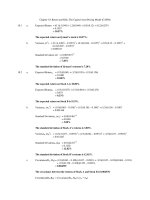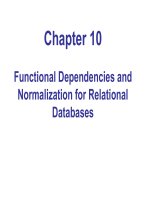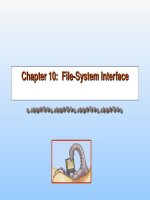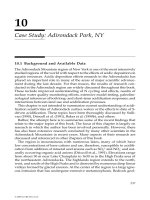Chapter 10 File-system interface
Bạn đang xem bản rút gọn của tài liệu. Xem và tải ngay bản đầy đủ của tài liệu tại đây (565.16 KB, 42 trang )
Chapter 10: File-System Interface
Chapter 10: File-System Interface
10.2
Silberschatz, Galvin and Gagne ©2005
Operating System Concepts – 7
th
Edition, Jan 1, 2005
Chapter 10: File-System Interface
Chapter 10: File-System Interface
■
File Concept
■
Access Methods
■
Directory Structure
■
File-System Mounting
■
File Sharing
■
Protection
10.3
Silberschatz, Galvin and Gagne ©2005
Operating System Concepts – 7
th
Edition, Jan 1, 2005
Objectives
Objectives
■
To explain the function of file systems
■
To describe the interfaces to file systems
■
To discuss file-system design tradeoffs, including access methods, file
sharing, file locking, and directory structures
■
To explore file-system protection
10.4
Silberschatz, Galvin and Gagne ©2005
Operating System Concepts – 7
th
Edition, Jan 1, 2005
File Concept
File Concept
■
Contiguous logical address space
■
Types:
●
Data
numeric
character
binary
●
Program
10.5
Silberschatz, Galvin and Gagne ©2005
Operating System Concepts – 7
th
Edition, Jan 1, 2005
File Structure
File Structure
■
None - sequence of words, bytes
■
Simple record structure
●
Lines
●
Fixed length
●
Variable length
■
Complex Structures
●
Formatted document
●
Relocatable load file
■
Can simulate last two with first method by inserting appropriate control
characters
■
Who decides:
●
Operating system
●
Program
10.6
Silberschatz, Galvin and Gagne ©2005
Operating System Concepts – 7
th
Edition, Jan 1, 2005
File Attributes
File Attributes
■
Name – only information kept in human-readable form
■
Identifier – unique tag (number) identifies file within file system
■
Type – needed for systems that support different types
■
Location – pointer to file location on device
■
Size – current file size
■
Protection – controls who can do reading, writing, executing
■
Time, date, and user identification – data for protection, security, and
usage monitoring
■
Information about files are kept in the directory structure, which is
maintained on the disk
10.7
Silberschatz, Galvin and Gagne ©2005
Operating System Concepts – 7
th
Edition, Jan 1, 2005
File Operations
File Operations
■
File is an abstract data type
■
Create
■
Write
■
Read
■
Reposition within file
■
Delete
■
Truncate
■
Open(F
i
) – search the directory structure on disk for entry F
i
, and move the
content of entry to memory
■
Close (F
i
) – move the content of entry F
i
in memory to directory structure on
disk
10.8
Silberschatz, Galvin and Gagne ©2005
Operating System Concepts – 7
th
Edition, Jan 1, 2005
Open Files
Open Files
■
Several pieces of data are needed to manage open files:
●
File pointer: pointer to last read/write location, per process that
has the file open
●
File-open count: counter of number of times a file is open – to
allow removal of data from open-file table when last processes
closes it
●
Disk location of the file: cache of data access information
●
Access rights: per-process access mode information
10.9
Silberschatz, Galvin and Gagne ©2005
Operating System Concepts – 7
th
Edition, Jan 1, 2005
Open File Locking
Open File Locking
■
Provided by some operating systems and file systems
■
Mediates access to a file
■
Mandatory or advisory:
●
Mandatory – access is denied depending on locks held and
requested
●
Advisory – processes can find status of locks and decide what
to do
10.10
Silberschatz, Galvin and Gagne ©2005
Operating System Concepts – 7
th
Edition, Jan 1, 2005
File Locking Example – Java API
File Locking Example – Java API
import java.io.*;
import java.nio.channels.*;
public class LockingExample {
public static final boolean EXCLUSIVE = false;
public static final boolean SHARED = true;
public static void main(String arsg[]) throws IOException {
FileLock sharedLock = null;
FileLock exclusiveLock = null;
try {
RandomAccessFile raf = new RandomAccessFile("file.txt", "rw");
// get the channel for the file
FileChannel ch = raf.getChannel();
// this locks the first half of the file - exclusive
exclusiveLock = ch.lock(0, raf.length()/2, EXCLUSIVE);
/** Now modify the data . . . */
// release the lock
exclusiveLock.release();
10.11
Silberschatz, Galvin and Gagne ©2005
Operating System Concepts – 7
th
Edition, Jan 1, 2005
File Locking Example – Java API (cont)
File Locking Example – Java API (cont)
// this locks the second half of the file - shared
sharedLock = ch.lock(raf.length()/2+1, raf.length(),
SHARED);
/** Now read the data . . . */
// release the lock
sharedLock.release();
} catch (java.io.IOException ioe) {
System.err.println(ioe);
}finally {
if (exclusiveLock != null)
exclusiveLock.release();
if (sharedLock != null)
sharedLock.release();
}
}
}
10.12
Silberschatz, Galvin and Gagne ©2005
Operating System Concepts – 7
th
Edition, Jan 1, 2005
File Types – Name, Extension
File Types – Name, Extension
10.13
Silberschatz, Galvin and Gagne ©2005
Operating System Concepts – 7
th
Edition, Jan 1, 2005
Access Methods
Access Methods
■
Sequential Access
read next
write next
reset
no read after last write
(rewrite)
■
Direct Access
read n
write n
position to n
read next
write next
rewrite n
n = relative block number
10.14
Silberschatz, Galvin and Gagne ©2005
Operating System Concepts – 7
th
Edition, Jan 1, 2005
Sequential-access File
Sequential-access File
10.15
Silberschatz, Galvin and Gagne ©2005
Operating System Concepts – 7
th
Edition, Jan 1, 2005
Simulation of Sequential Access on a Direct-access File
Simulation of Sequential Access on a Direct-access File
10.16
Silberschatz, Galvin and Gagne ©2005
Operating System Concepts – 7
th
Edition, Jan 1, 2005
Example of Index and Relative Files
Example of Index and Relative Files
10.17
Silberschatz, Galvin and Gagne ©2005
Operating System Concepts – 7
th
Edition, Jan 1, 2005
Directory Structure
Directory Structure
■
A collection of nodes containing information about all files
F 1
F 2
F 3
F 4
F n
Directory
Files
Both the directory structure and the files reside on disk
Backups of these two structures are kept on tapes
10.18
Silberschatz, Galvin and Gagne ©2005
Operating System Concepts – 7
th
Edition, Jan 1, 2005
A Typical File-system Organization
A Typical File-system Organization
10.19
Silberschatz, Galvin and Gagne ©2005
Operating System Concepts – 7
th
Edition, Jan 1, 2005
Operations Performed on Directory
Operations Performed on Directory
■
Search for a file
■
Create a file
■
Delete a file
■
List a directory
■
Rename a file
■
Traverse the file system
10.20
Silberschatz, Galvin and Gagne ©2005
Operating System Concepts – 7
th
Edition, Jan 1, 2005
Organize the Directory (Logically) to Obtain
Organize the Directory (Logically) to Obtain
■
Efficiency – locating a file quickly
■
Naming – convenient to users
●
Two users can have same name for different files
●
The same file can have several different names
■
Grouping – logical grouping of files by properties, (e.g., all Java
programs, all games, …)
10.21
Silberschatz, Galvin and Gagne ©2005
Operating System Concepts – 7
th
Edition, Jan 1, 2005
Single-Level Directory
Single-Level Directory
■
A single directory for all users
Naming problem
Grouping problem
10.22
Silberschatz, Galvin and Gagne ©2005
Operating System Concepts – 7
th
Edition, Jan 1, 2005
Two-Level Directory
Two-Level Directory
■
Separate directory for each user
■
Path name
■
Can have the same file name for different user
■
Efficient searching
■
No grouping capability
10.23
Silberschatz, Galvin and Gagne ©2005
Operating System Concepts – 7
th
Edition, Jan 1, 2005
Tree-Structured Directories
Tree-Structured Directories
10.24
Silberschatz, Galvin and Gagne ©2005
Operating System Concepts – 7
th
Edition, Jan 1, 2005
Tree-Structured Directories (Cont)
Tree-Structured Directories (Cont)
■
Efficient searching
■
Grouping Capability
■
Current directory (working directory)
●
cd /spell/mail/prog
●
type list
10.25
Silberschatz, Galvin and Gagne ©2005
Operating System Concepts – 7
th
Edition, Jan 1, 2005
Tree-Structured Directories (Cont)
Tree-Structured Directories (Cont)
■
Absolute or relative path name
■
Creating a new file is done in current directory
■
Delete a file
rm <file-name>
■
Creating a new subdirectory is done in current directory
mkdir <dir-name>
Example: if in current directory /mail
mkdir count
prog copy prt exp count
Deleting “mail” ⇒ deleting the entire subtree rooted by “mail”









